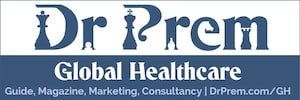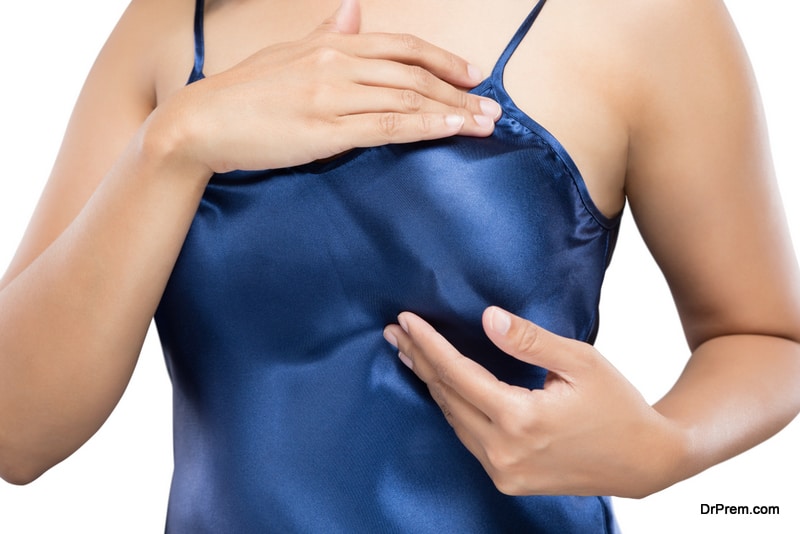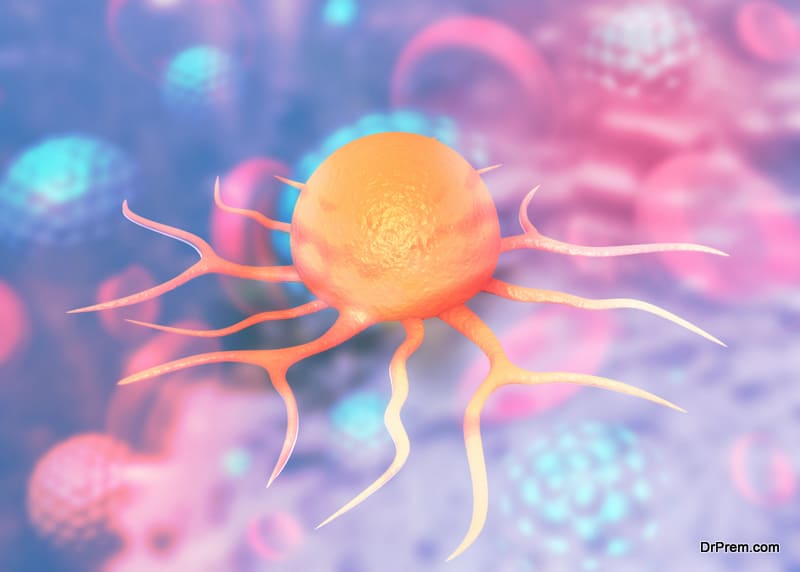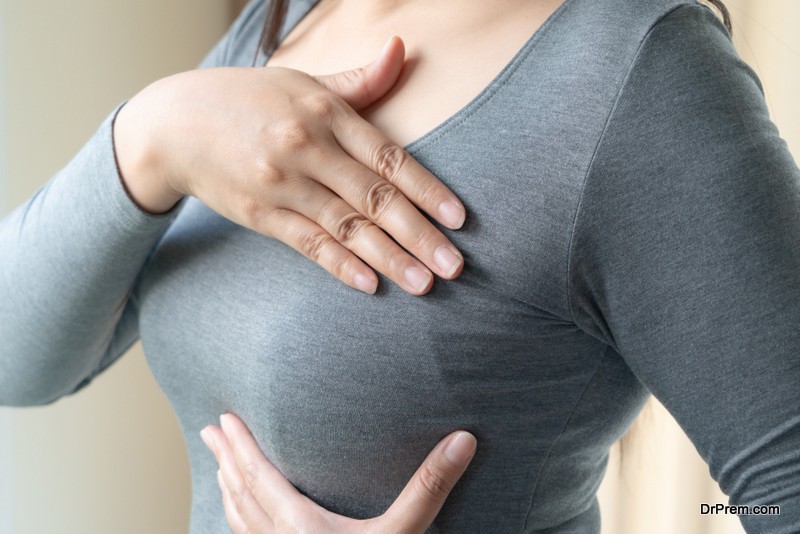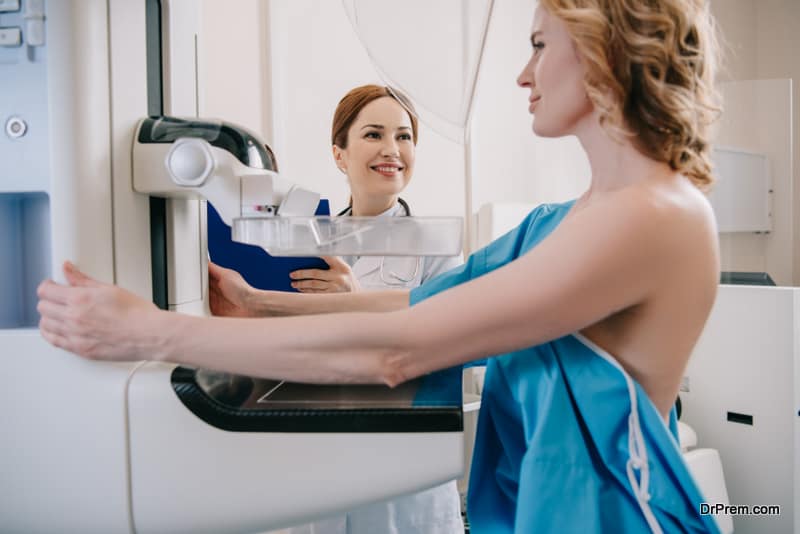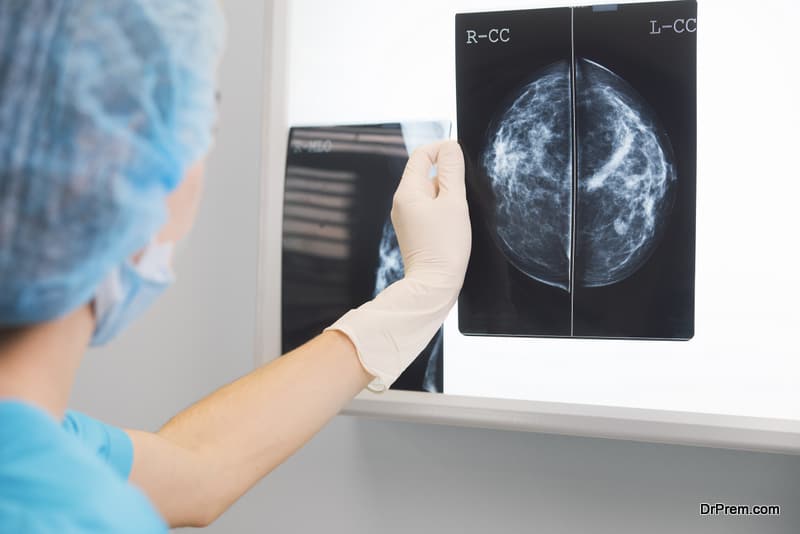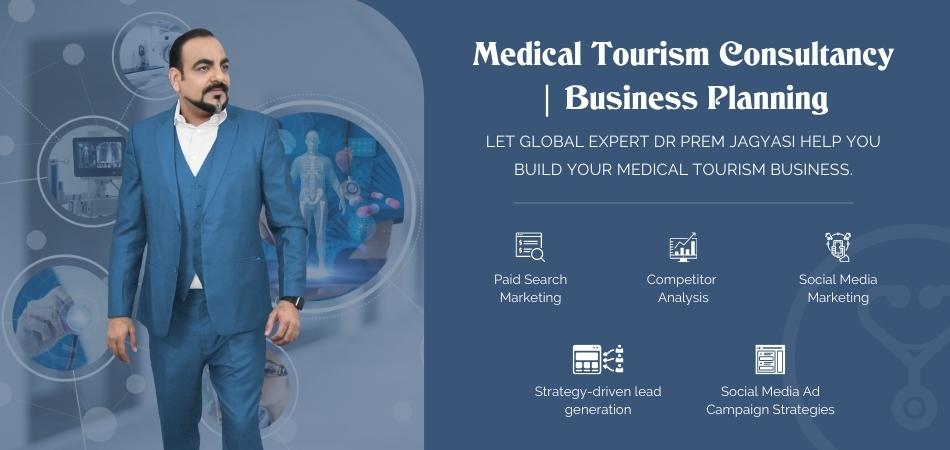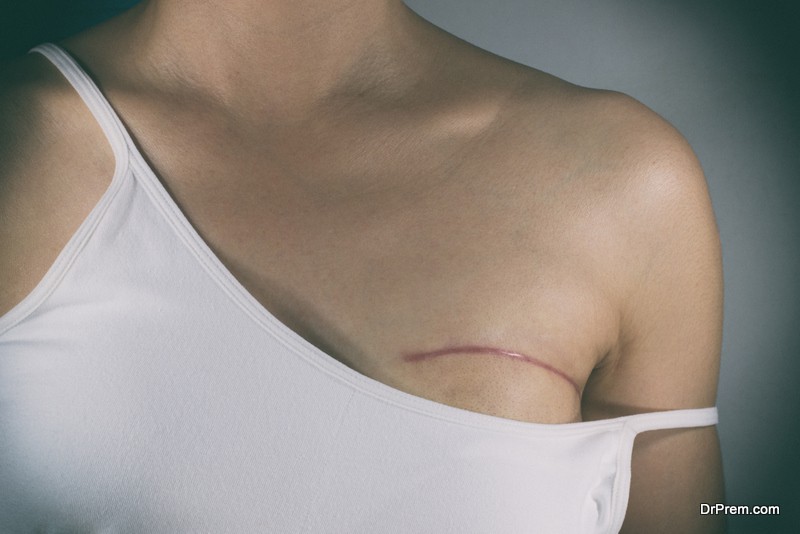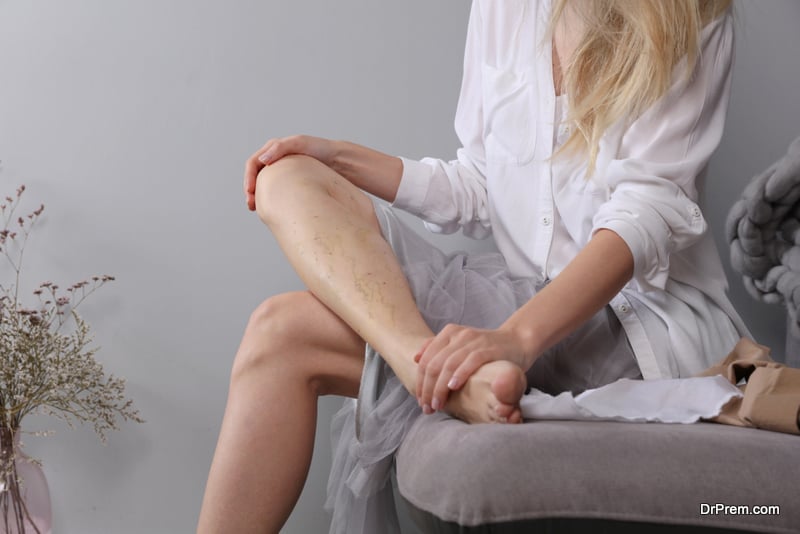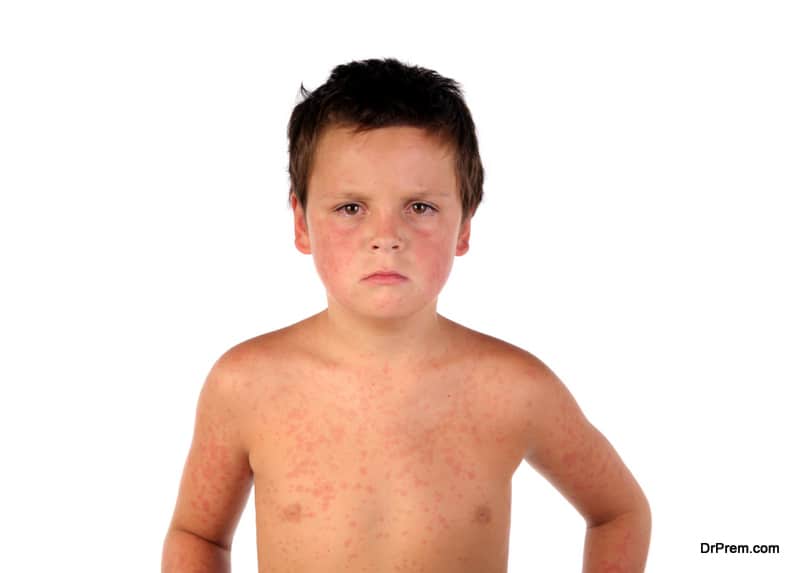Breast cancer affects 2.1 million women globally every year and is responsible for the highest cancer-related deaths among women. According to breastcancer.org, in the US, 1 out of 8 women, that is, 12%, will be impacted by breast cancer at some point of her life. However, the overall death rate from breast cancer in the US has dropped by 1.3% from 2013-17 owing to treatment advancements and timely screening.
Breast cancer is the uncontrolled growth and division of cells of the breast tissue in women. This growth can be benign in nature (one that remains within the breast) or malignant (one that spreads out of the breast tissue). It usually develops gradually and if it is of malignant type, the nodes in the armpit are also affected and can also invade other surrounding tissues like the lungs and the nearby bones.
What are the signs and symptoms?
The commonest sign of breast cancer is the presence of a lump or a mass in the breast. A mass which is painless, hard having irregular edges has greater chances of being cancerous in nature but there are soft, rounded and painful cancers also. Hence, it is essential that any mass or lump in breast is examined by a medical expert and help in early diagnosis of breast cancer.
Some of the signs of breast cancers include:
- Lump in specified area in the breast or overall swelling of the entire breast.
- Dimpling of the nipple or retraction of nipple
- Pain in nipple or breast.
- Changes in the breast skin like redness, itching or scaling
- Any discharge from the nipple
How is it diagnosed?
A through medical examination and case history can be helpful in determining the presence of a suspicious lump and the need to evaluate further. Medical case taking will reveal the early signs and symptoms, related health conditions, and other risk factors.
Breast examination –
This will reveal any changes in the color, texture of the breasts, presence of any lump or swelling, changes in nipple, retraction or discharges, etc.
Women can also learn the importance and correct way of breast self examination. This can be performed at home by self any suspicious findings can then be brought to the doctor’s notice.
Imaging tests–
Diagnostic imaging tests include, mammography, which is an X-ray of the breast. Others include breast MRI and ultrasound depending on the requirement. There are many other tests that can be performed as per the need and advice of the doctor.
These days there are a lot of improvement in the diagnosis, treatment and prevention of breast cancer. It is essential that women be alert about their health and plan preventive health check up at regular intervals and discuss any health changes with their doctor.
New cost effective diagnosis ends the agony of wait for results
Detection of breast cancer through MRI and Mammograms is an expensive affair causing agony to the already anxious patients. Adding to the agony of expenses that they need to incur, is the time taken for the results of the tests to arrive. Most of the test results are out after an anxious wait of couple of weeks. Patients now no longer have to go through the agony of waiting for weeks for the results to be out as Newcastle scientists have now made a breakthrough with a new method that would dramatically cut the cost and time to detect breast cancer among women.
The new technology uses a Roche ‘genome sequencer’ to test DNA for genetic abnormalities. The Swiss made machine produces results within hours of testing. This new method of testing would make detection of breast cancer more accessible to weaker sections of the society. Earlier and quicker detection also means saving lives by undergoing treatments at the appropriate times.
Says Professor John Burn, head of The Institute of Human Genetics at Newcastle University. This method of diagnosis would be a boon to those women who run a risk of inheriting breast cancer and also for women who could not afford expensive tests.
Breast Cancer: Are you aware of the risk factors?
The risk of developing breast cancer in women is growing by each passing day. At present 1 out of 10 women are diagnosed with breast cancer each day. Breast cancer goes unnoticed mostly because of the ignorance toward the early symptoms. Basically breast cancer involves the uncontrolled growth of menacing cells in the breast region.
Risk factors of breast cancer
No firm grounds have been established to know the exact causes of breast cancer. But most likely risk factors include
1. Age
The older you grow the more likely you are at risk. The growing age augments the chances of developing the symptoms. Therefore, if you are in your late 40s then you might need to be a bit more careful.
2. Genetically inherited
Breast cancer is easily carried through genes. A family history of your mother or sister having breast cancer increases the risk to 5 times.
3. Personal history
If you have breast cancer in one breast then you are more likely to develop it in the other.
4. Gender
Women susceptibility to risk is 100 times larger than men. Though rare, but breast cancer has been also found in men.
5. Hormonal disorder
Women who chose not to give birth or who bear their first child at a later stage of life mainly in late 30s need to be observant about any symptoms. The risk also increases if you had your first menstrual cycle, before the age of 12 or facing a delayed menopause after 50. Moreover, women who breast feed their child are less likely to get breast cancer.
6. Lifestyle
Chances of getting breast cancer are more if you drink alcohol and smoke regularly. Being overweight, obesity, and lack of physical activity enhances the risk further.
7. Race
Caucasian women are found to be more prone to breast cancer although breast cancer has proven to be more fatal in the case of black women.
8. Undergoing radiation therapies
You are more susceptible to develop breast cancer if you have had breast biopsies and radio therapies for chest. Breast cancer is very common in the case of cancer patients undergoing chemotherapy. The risk increases if the treatment was done at the age of puberty.
9. Preschool Diet For Adult Risk of Breast Cancer
Life’s early years are vital for moulding a child’s future! We are familiar with the notion. This is similar with too. Diet during the early years of life has been thought to play a role in many diseases. Researchers at Brigham and Women’s Hospital (BWH) found that regular consumption of French fries during preschool age was associated with a significantly increased risk of breast cancer! It is found in a study involving more than 2,000 female registered nurses. These findings are published in the online, early view issue of the International Journal of Cancer.
10 Ways to prevent breast cancer: Reducing the risk factors
- Boost your immunity with right foods like green tea, seaweed, kale, turmeric, garlic. Avoid eating too much of grape fruits as it may increase the breast cancer risk by 30%. High fat reaymade meals also pose a similar risk.
- Limit consumption of alcohol and red meat.
- Be body smart- remain physically active and manage your weight. Recreational workouts can significantly reduce breast cancer risks.
- Stop smoking
- Do not avoid breast-feeding
- Be cautious with hormone therapy, do not continue after a certain period of time
- Do not expose yourself to harmful radiation or pollution
- Check your family history
- Do self-examination of breasts regularly
- Do not skip routine mammograms
Self-examinations can help in early detection
A self examination by women during their daily routine is helpful in detecting the early signs. Follow the steps mentioned below:
- With the help of your fingers feel the area around breast, underarms, and collar bone.
- Look out for any uncharacteristic swelling or lump. The lump is generally painless on touching. Before jumping to any conclusion, learn about myths and facts of breast lumps and get it checked by a doctor.
- Observe any unusual appearance of the breast and nipple, i.e., size or color.
- Feel the texture of your skin around the breast and nipple. Cracking or unusual dryness can be an alarming sign.
- Check any discharge of fluid or blood from the nipple.
- Observe persistent pain in the breast or a particular area.
- A persistent inflamed appearance of the breast or nipple.
Observe all the above mentioned symptoms carefully and consult your doctor immediately, if you have any of these symptoms.
How to treat breast cancer
Nowadays the following treatments either individually or in combination are opted to cure breast cancer:
1. Mastectomy
The lump is surgically removed. But in severe cases the whole breast is dissected since it’s not one of the vital organs for survival.
2. Radiotherapy
It destroys the cancerous cells without harming the other body cells and tissues. Chemotherapy is opted if the cancer has spread in other body parts. It destroys the cancerous cells but also affects the healthy cells like cells causing hair growth, but often side effects get better post therapy.
3. Hormonal therapy
In some cases doctors recommend hormonal treatment using “tamoxifen” but only in the less severe cases.
10 tips for a healthy recovery from breast cancer treatment
Recovery from breast cancer treatment involves both physical and mental healing. For most women, it is an emotional journey as it is quite tough to adapt to the new changes and lifestyle modifications after breast cancer surgery. In case of a lumpectomy, recovery is quite fast and uneventful but mastectomies are more complicated and need at least 3-4 weeks to get back the normal energy levels.
But healthy recovery without any unforeseen events is what you would look for which is achievable with the help of following tips. These should be tried only after being approved by the doctor.
-
Move your arm:
Just remaining idle for hours after the operation is not good for your mental or physical health. On the other hand, it ups your risk for deep vein thrombosis which can give rise to embolism in lungs, a life-threatening condition. It is important you try gently moving your arm to the side where mastectomy is done.
Try to use your arm normally for your regular activities like combing hair, dressing up, bathing and eating. While lying down, raise your arm above your heart and keep it for 45 minutes. Practice this exercise 2-3 times a day.
Keeping the arm raised, close and open your hands for 15-25 times without causing any discomfort. Try to bend and straighten your elbow. Practice this exercise 3-4 times a day. This would help in reducing the swelling by draining out the accumulated lymphatic fluid.
-
Manage your pain:
The pain would persist for few more days post operation which may turn out be severe at nights. Your doctor will prescribe some painkillers. Make sure to keep them handy so that you need not hunt for those especially when required.
-
Check your drains:
In case of mastectomy, the surgeon is likely to install hoses to drain out the fluids to prevent swelling around the operated area. You need to check the fluid drainage regularly and report to the surgeon who will take out the drains at proper time which is normally after 1-2 weeks of operation.
-
Be enthusiastic about participating in a wellness plan:
Develop a wellness plan with the help your care team that would take care of your mental, emotional and physical wellbeing. You can include counselors in the team to meet your social and spiritual wellness and set yourself to a speedy recovery track. You may need to consult several providers if there are too many side effects to manage.
-
Communicate with your doctor and care team often:
It is very important to assess your recovery. Never hesitate to report any side effect or problem that you would be facing post breast cancer surgery. You may be experiencing tightness in chest muscles, sleep disturbances or extreme fatigue. Your care team should be aware of these issues and suggest proper ways of recovery.
-
Practice deep breathing exercises:
Lie down and take a deep breath slowly. Inhale as much air as you can and expand your chest and abdomen. Breathe out gently. Repeat this step 4-5 times. This would enable normal functioning of your chest muscles and lungs. Do breathing exercises at least 6 times a day.
-
Manage your menopausal symptoms:
Breast cancer can cause menopausal symptoms like night sweats, hot flush, mood swings and weight gain which are likely to affect your daily activities. You need to be in touch with your GP to manage these symptoms.
-
Maintain a record of your fatigue:
Dealing with fatigue is quite common while recovering from breast cancer treatment. Maintain a record of your fatigue giving a rating within the scale 1-10 to determine the level of energy you are maintaining throughout the day.
-
Practice yoga and mindfulness:
While on breast cancer treatment, lots of worries regarding your future may disturb your mind. Practicing mindfulness would help in maintaining your focus to the present activities to be done to speed up your recovery. You can use a mindfulness app or take guidance from a professional to improve your mental well being. Studies show yoga helps in faster recovery from breast cancer.
-
Follow a nutritious and healthy diet plan:
This is a must to quicken your recovery from breast cancer treatment. A nutritious diet would help you regain your energy faster. Consult a dietician to chalk out the right diet plan for you. Fresh vegetables, fruits and grains are recommended to maintain your energy and body weight. Quit smoking and limit your drinking.
How to deal with breast cancer
Breast cancer takes a serious physical and emotional toll. Managing stress and anxiety along with proper self-care becomes an ordeal. During this phase, support from family and the close circle matter a lot. The more you share lesser are your pains and anguish. You need to frame specific coping strategies of course with the help of your family and care givers. Joining support groups on social media also help in boosting your self-confidence to tide over the situation. Read more tips to deal with breast cancer.
Frequently Asked Questions
- At what age it is advisable to get a regular checkup?
A. It is generally advisable to get a checkup done once in a year if you are in your 40s. - What precautions are to be taken to avoid breast cancer?
A. Breast cancer cannot be avoided. Even women with a healthy lifestyle develop this disease many times. But the most essential precaution to be taken is not to ignore any early symptoms. A good observation through eyes and touch at home can prove to be beneficial. - Can smoking and alcoholism lead to breast cancer?
A. Yes, an unhealthy life style increases the risk of developing breast cancer.
Breast cancer awareness – The need of the hour
Breast cancer today is a major public health problem all over the world. Previously, it was assumed to be a problem of the developed countries but lesser wealthy nations are not spared either. Lack of knowledge, awareness and education can raise the number of patients significantly. The need is to spread awareness in different socio-economic strata where women can take timely actions and necessary measures to prevent it. It is good that many high profile celebrities are playing important roles in spreading breast cancer awareness. The more is the reach better it is for public health.
